Gary Neal Hansen's Blog, page 12
December 9, 2021
A Children’s Sermon on Luke 3:7-18–Growing Good Fruit
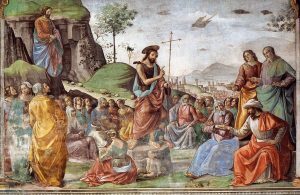
 Domenico Ghirlandaio, The Preaching of St. John the Baptist (public domain)
Domenico Ghirlandaio, The Preaching of St. John the Baptist (public domain)For the 3rd Sunday ol Advent I bring you a children’s sermon on Luke 3:7-18. That’s right: in Year C the heretofore backward Advent journey to Bethlehem takes a halting step forward on week three.
(You can find my regular Monday Meditation on this text through this link.)
Last week we were with John the Baptist, as foreseen by Isaiah, calling all to make straight paths for the coming Messiah.
This week we continue that same scene in a series of conversations between John the Baptist and various repentant people trying to figure out which mountains to mow down and which valleys to fill up.
What’s the particular challenge of writing a children’s sermon on Luke 3:7-18? I suppose it’s trying to avoid sounding too scary, or too angry. John really tears into them at the start of the passage.
Can I avoid doing that and still be on target biblically? You tell me, either in the comments or by email.
A Children’s Sermon on Luke 3:7-18Good morning kids! I’m so glad you’re here at worship today. Thanks so much for coming up to hear the children’s sermon.
Happy third Sunday of Advent! We’re past the half-way point on our journey to Christmas. We’re getting closer and closer to our celebration of the birth of Jesus.
You may remember how our gospel readings have been taking us the long way on our journey to Bethlehem.
Two weeks ago we were way in the future, waiting for Jesus to come back at the end of the age.Last week we were with John the Baptist waiting for the grown-up Jesus to start his ministry.Well, where are we this week?
We’re still with John the Baptist, waiting for the grown-up Jesus!
Trying to Take the Easy WayIn last week’s story, John the Baptist was out in the wild lands along the River Jordan. He was telling people to get ready for the Messiah to com.
“The Messiah is coming!” John would tell them. “It’s my cousin Jesus! He’s the one the prophets said would come and save us!”
Once enough people had listened to his message John would tell them how to start getting ready. “If you want to get ready for the Messiah, you need to come down into the river and I’ll wash you, head to toe.”
“Okay,” said one grumpy guy in the crowd, “let’s get this over with.”
And he walked down to join John the Baptist by the river’s edge:
“What do you mean ‘get it over with’?” asked John.
“You said I need to get washed in the water,” he said. “Let’s get it done so I can get back to work. I’ve got a lot to do, and this is wasting too much time.”
“Look,” said John, “I understand that you need to get back to your job. But it doesn’t really sound like you’re taking this seriously.”
“What’s so serious?” the grumpy guy asked. “You said if I got washed I’d be ready for the Messiah. Wash me up fast. I’m a busy man.”
“Maybe you missed part of the message,” said John. “Getting washed just shows you’re ready. It’s God’s way of showing you that he’s giving you a new clean start on life. But there’s more to getting ready. You need to learn a new way of thinking. That’s what will help you figure out what to do with your new clean life.”
Bearing FruitSome of the people standing nearby heard what John said to the grumpy guy. So they stepped up closer to ask some questions.
“What do you mean when you say we need a new way of thinking?” they asked.
“It’s like this,” said John. “We all grow up thinking mostly about ourselves. We know God made us, but we don’t think about it much. To be ready for the Messiah, you need to start to see the world the way God sees it.”
“What do you mean?” they asked. “How does God see the world?”
“For one thing,” John said, “God sees that he made the whole world, and everything in it. It belongs to him, and not to us. For another thing, God loves every single person he made. He loves you. But he also loves your neighbor. Even if your neighbor isn’t very nice.”
John didn’t mean to, but he glanced at the grumpy guy when he said that.
“And we’re supposed to think that way too?” someone asked.
“Exactly,” said John.
“But that’s gonna take a lot of work.” said the grumpy guy. “That’s gonna take a lot of time.”
“Think of it like planting a tree,” said John. “You start right now: you plant a seed. Then you water it—maybe by coming into this river. Eventually the good seed grows into a good tree. And a good tree starts to grow good fruit. You all need to grow some fruit!”
Kinds of fruit.One of the people standing by said, “So what kinds of fruit do you think we should be growing?”
“The main thing,” said John, “is you need to care for the people God loves. If you have more than enough clothes, and you find out someone doesn’t have enough clothes—well then, share. Same with food. If you have more than enough, and your neighbor doesn’t have enough—then share.”
“What about me?” asked the grumpy guy. “I’m a tax collector. What should I do?”
John said, “Do the right thing. Collect just the correct, honest amount. No cheating.”
“What about us?” asked a couple big guys, who were wearing armor and swords. “We’re police officers. What should we do?”
John said, “You have that job to help people. So do the right thing. Don’t use your power to scare people, or hurt people, or to get money. Help people instead.”
Good News.“I don’t know,” said the grumpy guy. “This sounds like a lot of work. Seems kind of depressing.”
“Actually,” said John, “it’s really good news. The Messiah is really coming. And he really wants to be with you. And if you grow that seed so you bear good fruit, you’ll be ready to be with him!”
WonderingI wonder if anyone today thinks that all we really need to do is get baptized to be ready for Jesus to come?I wonder what could help you learn to think the way God thinks?I wonder what would help God’s way of thinking grow like a big strong tree inside you?I wonder what kind of good fruit could come from you when you think the way God thinks? ++++++++++++You are, of course, free to use this children’s sermon, or adapt it as you find most useful. But, if you use it, please do one (or more!) of the following.
You can let me know that you are using it, either in the comments below, or using the contact form above. You can put a little notice in your church bulletin that your children’s sermon is adapted from one published on GaryNealHansen.com.You can support my work over on Patreon. (Just $1 per month brings my children’s sermons straight to your inbox about two minutes after they go live. And every little bit keeps me going…)The post A Children’s Sermon on Luke 3:7-18–Growing Good Fruit appeared first on Gary Neal Hansen.
December 3, 2021
A Children’s Sermon on Luke 3:1-6–Straight Paths
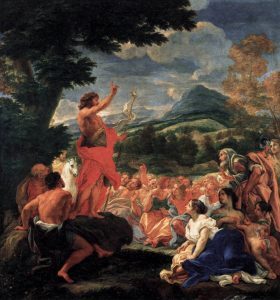
 Baciccio, The Preaching of St. John the Baptist (public domain)
Baciccio, The Preaching of St. John the Baptist (public domain)For the second Sunday of Advent in Year C of the lectionary, I bring you a children’s sermon on Luke 3:1-6. (You can find my regular Monday Meditation on this passage through this link.)
In these lectionary readings we’re still nowhere near Bethlehem. The challenge is explaining to kids why we prepare for the birth of Jesus by hearing about stuff John the Baptist did when Jesus was thirty years old.
But that’s how Advent works, at least in the Revised Common Lectionary. We move backward in time toward Bethlehem. First we look to the future. Second we welcome the grown-up Jesus. Soon, in the last half of Advent, we’ll turn our attention to the coming of the baby Jesus.
More challenging still is that I really want to talk about the quotation from Isaiah, with its call to level the mountains and fill the valleys. There’s a twist I do not remember thinking about before: all this roadbuilding is not for US to get to JESUS. It’s all for JESUS to get to US.
That’s challenging for a children’s sermon because it’s all metaphors. Most kids coming up for a children’s sermon don’t yet have the brain development to grasp metaphors. So I’m doing this with the strong suspicion that it may well miss the mark. If you use it, please let me know your thoughts on this question, especially if you get a sense of how the kids respond.
Nevertheless, no matter how great the risk of being developmentally off target, here’s my children’s sermon on Luke 3:1-6.
A Children’s Sermon on Luke 3:1-6Good morning kids! I’m so glad you’re here today. thanks for coming up to hear the children’s sermon.
AdventToday is the Second Sunday of Advent.
You probably remember that Advent is our time of getting ready for Christmas. At Christmas we celebrate that Jesus was born in Bethlehem—that God decided to come to us in person, as one of us. Jesus was born as a tiny baby, just like you were.
Well how do we get ready to welcome Jesus as a tiny baby? Our Gospel readings in Advent show us a surprising way of getting ready. It’s a strange journey to Bethlehem.
Advent is about Jesus coming to us. Last week, on the First Sunday of Advent, we looked to the future, to the very end of time, when Jesus will come back to us from heaven.
This week we take a big step backward in time. From the end of time we go back to when Jesus came to us as a grown-up.
You remember how, when Jesus was a grown-up, he did wonderful things. He healed sick people. He fed hungry people. He welcomed lonely people. And everywhere he went, he taught everyone he met about the Kingdom of Heaven.
That’s how Jesus came to us as a grown-up. Here’s what happened just before Jesus started doing all those wonderful things.
John the BaptistJesus had a cousin named John. We call him “John the Baptist,” because John went out into the wild lands along the Jordan River and baptized people, washing them in the water.
John would tell the people “the Messiah is coming! It’s my cousin Jesus! You need to get ready!”
Well, one day somebody asked him, “How should I get ready?”
John answered, “You need to learn to think in whole new ways! You need to learn to think the way God thinks, so you can live God’s way.”
The person John was talking to looked down at his feet He didn’t want to look John in the eye.
“It’s hard to change,” he said. “I’ve been thinking in my old ways a long time. I haven’t lived God’s way. I’ve done lots of things I’m ashamed of.”
John said “Its going to be okay, my friend. Come into the river and I’ll wash you in the water.”
Baptism“Wash me in the water?” said the man. “What good will that do?”
“Lots of good,” said John. “For one thing you’ll remember forever that God forgives you. He washes you clean on the inside, just like I wash you clean on the outside!”
“Okay,” said the man. “That’s one good thing about getting washed. But it sounded like you thought there were lots of good things.”
“Right,” said John. “Getting washed will also make it easier to get close to my cousin Jesus.”
“How’s that?” the man asked.
Isaiah’s Poem“It’s like something the prophet Isaiah said in the Bible. It was in a poem full of word pictures. It went something like this:
“Make straight paths,
because the Lord is coming!
Make bridges across the valleys!
Make tunnels through the mountains!
If the roads are rocky, sweep them clean!”
“Hmm…” said the man. “You want me to go build good straight roads so that I can go see this Jesus guy when he shows up?”
“Sort of,” said John, “but not quite. You need straight roads so that Jesus can come to you.”
“So which mountains do I dig through?” he asked. “The ones between here and Jerusalem? Which valleys do I need to build bridges across?”
Mountains and Valleys Inside Us“It’s not about mountains made of rocks, or valleys with rivers,” said John. “It’s all about things inside of you.”
“Mountains inside of me?” asked the man. “What are you talking about?”
“If there’s a great big mountain of angry grudges between you and God,” said John, “then you need to do some digging to move that mountain away. Build a straight road for Jesus. And if you have a big hole inside you, an empty place like a valley, you need to see how you can fill it up to make a straight road for Jesus.”
“I’m worried,” said the man, “If I can’t make all the roads straight maybe Jesus won’t come to me!”
“That’s not the way it works,” said John. “Jesus is coming to you no matter what. Isaiah said everyone in the world would see him coming. But you can make it easier for him to get to you if you remove the rocks from the road.”
WonderingI wonder if that man understood what John the Baptist said about learning to think in new ways?I wonder if he understood what John meant about making straight roads inside for Jesus?I wonder if you can think of any mountains or valleys or rocks inside you that might slow Jesus down on his way to be with you?++++++++++++You are, of course, free to use this children’s sermon, or adapt it as you find most useful. But, if you use it, please do one (or more!) of the following.
You can let me know that you are using it, either in the comments below, or using the contact form above. You can put a little notice in your church bulletin that your children’s sermon is adapted from one published on GaryNealHansen.com.You can support my work over on Patreon. (Just $1 per month brings my children’s sermons straight to your inbox about two minutes after they go live. And every little bit keeps me going…)The post A Children’s Sermon on Luke 3:1-6–Straight Paths appeared first on Gary Neal Hansen.
November 24, 2021
A Children’s Sermon on Luke 21:25-36

 CC by Liesel-SA 3.0 unported
CC by Liesel-SA 3.0 unportedFor the first Sunday of Advent, I bring you a children’s sermon on Luke 21:25-36.
The folks who put together the Revised Common Lectionary were not thinking about the preachers of children’s sermons when they set this up. The whole Advent series needs a lot of careful explaining, even for grown ups. Heaven help the children.
The kids know the key thing already: Advent is about getting ready for the birth of Jesus. But in its very traditional way the lectionary starts us off with Jesus’ scary predictions of the end times.
It’s also a challenge to help kids get a sense of the flow of the Gospel story from week to week. A couple weeks back we had Mark’s version of some of the same end times stuff. Then last week it was Jesus talking to Pontius Pilate, technically a Good Friday text. And now, we’re back to the apocalypse.
I want to avoid making the run-up to Christmas seem frightening. It’s bad enough with the popular threats about Santa Claus. You know: “He sees you when you’re sleeping! He knows when you’re awake!” Plus, he’s keeping a tally of your behavior, so shape up.
(Personally I benefit more from the journey I take in my Advent class on lectio divina. We go through the great songs of Luke’s Gospel about the coming birth of Jesus—songs by Gabriel, Zechariah, Mary, and Simeon. And if that sounds good to you, there’s still time to sign up!)
But since your church works with the lectionary, and you need to talk to the kiddos this Sunday, here’s my children’s sermon on Luke 21:25-36.
A Children’s Sermon on Luke 21:25-36.Good morning kids! I’m so glad you are here today. thanks for coming up to hear the children’s sermon.
Today is a very special day in the church. Today is the first Sunday of Advent. It’s the beginning of a brand new year in the life of the church.
I think you may know what Advent is. Advent is the four weeks we spend getting ready for the birth of Jesus at Christmas. Jesus’ birth is so important, so amazing, that we just have to spend time getting ready.
There is a funny thing, though, about how the church helps us get ready for Christmas.
Every year, on the first Sunday of Advent, the Gospel reading is a story of Jesus. But it isn’t the story of Jesus being born. That doesn’t come till Christmas. On the first Sunday of Advent, we hear Jesus talking about coming back at the end of the world.
Every year we start Advent with scary stories about things going wrong and people suffering. It might seem like a strange way to get ready for Christmas. But I think there is a reason.
Skipping to the Last PageMaybe it’s like this: Sometimes, when people read story books, they read the last page before they actually read the middle. If the middle of the book is too scary, people want to know that it’s all going to be okay in the end. They want to know that their favorite character survives, and the story ends happily.
Sometimes real life is hard and scary too. Maybe sometimes you’d like to skip to the end and know that things are going to turn out okay for you.
Well, on the first Sunday of Advent, the church lets us flip to the end of the book, to the end of the story of our world. Yes, Jesus tells us, we are going to go through some hard things. But in the end, he’s going to come back. It’s all going to be okay. The story of this world has a happy ending.
Advice for the MeanwhileIn today’s reading, Jesus tells us that when we see bad things happening in the world, we can stand up and be hopeful. Seeing hard things happening means we are that much closer to the time when Jesus makes it all okay.
Here, and in just about all the places where Jesus talks about the end of the world, he has two pieces of advice.
Jesus tells us to keep alert. And Jesus tells us to pray.When things are hard for you or for the world, Jesus says the thing to do is pay close attention. He doesn’t want us to hide and be afraid. He wants us to look around and be ready to do whatever needs to be done.
And when things are hard for you or for the world, Jesus says the thing to do is to pray—to call out to God for help. Because God is always listening, and God always cares.
And God can send help from the most surprising places, in the most surprising ways. Sometimes God sends help from other people. And sometimes God sends help from deep inside you, where strength and courage come from.
WonderingI wonder if thinking about Jesus coming back to us in the future is a good way to get ready to celebrate Jesus coming the first time, long ago?I wonder if it helps you when life is hard to know that the story of life has a happy ending?I wonder if when your life is hard whether it might help to keep alert and pray?++++++++++++You are, of course, free to use this children’s sermon, or adapt it as you find most useful. But, if you use it, please do one (or more!) of the following.
You can let me know that you are using it, either in the comments below, or using the contact form above. You can put a little notice in your church bulletin that your children’s sermon is adapted from one published on GaryNealHansen.com.You can support my work over on Patreon. (Just $1 per month brings my children’s sermons straight to your inbox about two minutes after they go live. And every little bit keeps me going…)The post A Children’s Sermon on Luke 21:25-36 appeared first on Gary Neal Hansen.
November 17, 2021
A Children’s Sermon on John 18:33-37–Christ the King
 [image error]Christ Pantocrator, Cefalu Sicily (cc by Gun Powder Ma-SA 4.0)
[image error]Christ Pantocrator, Cefalu Sicily (cc by Gun Powder Ma-SA 4.0)It is “Christ the king” this Sunday, or “The Reign of Christ,” so I offer you a children’s sermon on John 18:33-37. (You can find my regular Monday Meditation on this text here.)
Next week Advent begins—a whole new year for the church. Most of our Gospel texts will be from Luke. (If you’d like to make this Advent a time of spiritual focus, and jump start your time in Luke, think about joining my Advent course on classical lectio divina. We’ll be exploring this ancient Christian prayerful approach to Scripture on four great texts from Luke. Find out more through this link.)
But for now… a children’s sermon on John 18:33-37.
A Children’s Sermon on John 18:33-37Good morning kids! I’m so glad you’re here today. Thanks for coming up to hear the children’s sermon.
Today is a special day in the church. It’s the last Sunday of the church’s year. Today is called “Christ the King,” or “The Reign of Christ.”
The End of the Church YearEvery year, the church celebrates the events of Jesus’ life.
We start as Winter is coming. In Advent we have four Sundays of getting ready for Jesus to be born on Christmas. Christmas is so important we keep celebrating it for two more Sundays.
Then, in the middle of Winter, for several Sundays we celebrate how Jesus’ life is good news for the whole world. That’s called “Epiphany.”
Some churches celebrate Epiphany by remembering how the magi came from a far away county to bring gifts to Jesus. Other churches celebrate Epiphany by remembering how Jesus was baptized when he started going out to help people.As Winter is turning to Spring we celebrate Lent. That’s the six Sundays when we get ready for Holy Week.
In Holy Week we remember the last week of Jesus’ life on earth.
On Palm Sunday we remember Jesus riding joyfully into Jerusalem.On Maundy Thursday we remember Jesus giving his friends the Lord’s Supper.On Good Friday we remember Jesus gong to his death on the cross.Then on Easter Sunday, we celebrate that Jesus rose from the grave and was alive again—that he rose to give us new life too.
Forty days later we celebrate the Ascension, when Jesus went up to heaven.
And soon after that we celebrate Pentecost, when Jesus sent the Holy Spirit to help the church grow, and be strong, and reach out with the good news of Jesus.
Then, all through the summer and fall we have what the church calls “Ordinary Time.” That’s the growing time when we listen to Jesus’ stories, and try to live the way he teaches us.
Christ the KingWell, today is the very last Sunday of Ordinary Time. It’s the very last Sunday of the whole church year. Next Sunday we start the new year with the season of Advent—getting ready for the birth of Jesus again.
But today we are looking back at all we’ve learned about Jesus in our year-long journey of celebrations.
What have we learned? Only you know what you learned. But I can tell you what the church has tried to teach us in our year-long journey.
Its’ right there in the name of this last Sunday of the church’s year: “Christ the King,” or “the Reign of Christ.”
What we’ve learned is that Jesus is our true king—our ruler.
Jesus told lots of stories about the Kingdom of heaven. Now we know that Jesus is the ruler of that Kingdom—and of our lives.
Maybe you are thinking “Hey, how can Jesus be the king? We don’t have kings in our country.” Or, “If Jesus is king, what’s he doing?”
Someone in today’s Gospel story had questions just like that.
Talking with the GovernorThe Gospel story today is a conversation between Jesus and the governor, a man named Pontius Pilate. Pilate wanted to know if Jesus really thought he was a king, and what kind of king Jesus was. Here’s what happened.
“Are you really a king or what?” asked the governor.
“Why are you asking?” said Jesus. “Did somebody say you should ask me that?”
“Seriously!” Pilate said. “Are you really a king or what?”
“I’m not the kind of king you are used to,” Jesus said. “My Kingdom isn’t like kingdoms in this world.”
“But then what kind of king are you?” Pilate said. “What kind of kingdom do you have?”
“Here’s the secret,” said Jesus. “‘King’ and ‘Kingdom’ are earth words. I’m more a ‘heaven’ sort of king. My kingdom is all about knowing what’s really true. That’s why I’m here, actually: I came to speak the truth. And people who love the truth hear my voice and follow me. How about you?”
That’s where our reading ends. If we read just one more verse, we would hear Pontius Pilate’s answer.
When Jesus said that people who love the truth follow him, Pontius Pilate asked “What is truth?”
WonderingI wonder which season of the church’s year you like best.I wonder what Pontius Pilate thought about Jesus being a king whose job was to just tell the truth?I wonder if you’ve ever heard Jesus telling you the truth?I wonder if you would like to live in Jesus’ kingdom?++++++++++++You are, of course, free to use this children’s sermon, or adapt it as you find most useful. But, if you use it, please do one (or more!) of the following.
You can let me know that you are using it, either in the comments below, or using the contact form above. You can put a little notice in your church bulletin that your children’s sermon is adapted from one published on GaryNealHansen.com.You can support my work over on Patreon. (Just $1 per month brings my children’s sermons straight to your inbox about two minutes after they go live. And every little bit keeps me going…)The post A Children’s Sermon on John 18:33-37–Christ the King appeared first on Gary Neal Hansen.
November 15, 2021
“Praying with Scripture” on The Way Podcast
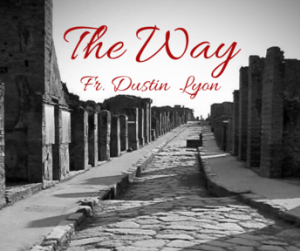
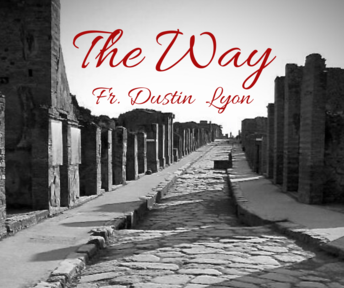 Fr. Dustin Lyon’s “The Way” on the Ephesus School Network.
Fr. Dustin Lyon’s “The Way” on the Ephesus School Network.My good friend Fr. Dustin Lyon, with whom I used to regularly pray Orthodox vespers on Saturdays, hosted me on his podcast to talk about praying with scripture.
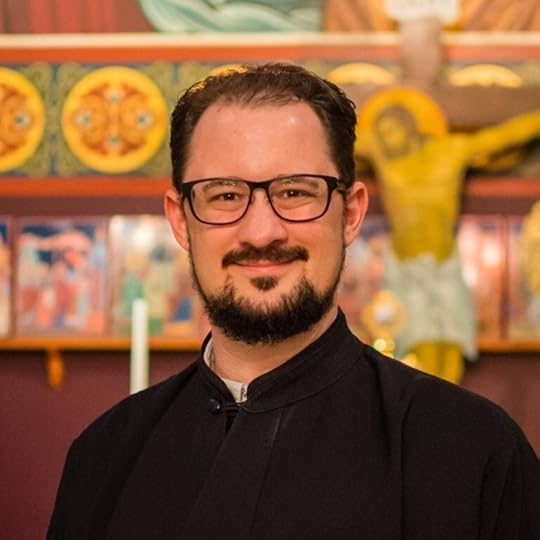
Fr. Dustin’s podcast is called “The Way” and it’s hosted with an active group of Orthodox Christian podcasts called “The Ephesus School Network.” On the page with my episode you’ll find a link the podcast’s main page, which will also link you to the whole nework.
This was actually a year ago, but somehow I never posted it here. (Sorry Fr. D.!) However, now’s a very good time to share it with you. I’m hoping it will draw your interest to my upcoming Advent class on classic lectio divina.
There is hardly a more loved and widely practiced way of praying with Scripture than lectio divina. Developed in monastic life, it is way to dive deep into Scripture with more than just intellectual study. It includes study, but it doesn’t stop there. It includes more meditative, prayerful, and contemplative ways of making the Bible part of your relationship with God.
I talk about lectio divina at about the ten minute mark in the podcast, and later on as well.
In my class we’ll explore and learn and practice the classic medieval form of lectio divina. There are several other practices that are today called by the same name, but I’m convinced the classic medieval form will take you deeper into both prayer and scripture.
It’s all built around making Advent a time of real spiritual focus. Each week we’ll practice classic lectio divina on one of the four great “songs” in the nativity narrative of Luke’s Gospel.
It’s tons of fun. I’d love to have you join us.
Registration will start this Sunday, and will stay open for a week until the first day of Advent. Full info and the waiting list sign-up are through this link.
Here’s the link to the podcast episode:
Praying with Scripture, on “The Way” with Fr. Dustin Lyon++++++++++++
By the way, the key resource for the class is my little book Love Your Bible: Learning to Pray with History’s Best Teachers. You can get a free ebook copy by subscribing to my newsletter if you scroll down just a bit.
The post “Praying with Scripture” on The Way Podcast appeared first on Gary Neal Hansen.
November 12, 2021
A Children’s Sermon on Mark 13:1-8 — The End of the World?
 Temple Mount, Southwest Corner (CC by David King 2.0)
Temple Mount, Southwest Corner (CC by David King 2.0)It’s Wednesday night and I’m finally sitting down to write my children’s sermon on Mark 13:1-8. It won’t come out till Friday. Argh! (Here’s a link to my regular Monday Meditation on this text from a while back.)
I try to get these out to you on Monday but a full-time intensive online course this week has kept me from my normal routine.
It may not seem like it’s all that late for a children’s sermon. I had my share of Sundays where the first thought I was able to give to the children’s sermon was Sunday morning. Like during the Prelude.
But that’s a stressful way to live. And it’s no way to treat the task of preaching, especially to kids, where the sermon is basically cross-cultural communication. Not only do I need prayerful study of the text and a solid sense of the point I want to make. I also have to translate it into terms that will make sense to a five or eight year old.
So, I know it’s better to give a children’s sermon some time to percolate. Especially this week when my children’s sermon on Mark 13:1-8 takes me into the “little apocalypse.” Lord knows I don’t want to talk about Jesus’ predictions of the end times without some advance preparation.
A Children’s Sermon on Mark 13:1-8Good morning, kids! Im so glad you’re here today. Thanks for coming up to hear the children’s sermon. This part of the service is just for you.
Big BuildingsOne day Jesus and his friends had been praying in the Temple. As they walked out, Bartholomew, one of the disciples, was looking all around. His eyes got so big, and his mouth dropped wide open.
“Wow!” Bartholomew said, “Jesus, can you believe the size of these buildings? Just look at these huge stones they’re built from!”
A couple of the disciples started laughing at Bartholomew. They’d been to Jerusalem before.
“Oh come on, Bartholomew!” someone said. “Haven’t you seen big buildings before? Where did you come from, anyway?”
“A little village,” said Bartholomew, “just south of Samaria. This is the first time I’ve ever been so far from home.”
“Yep,” said Jesus as they walked along, “these buildings are huge. But I’ll tell you a secret: One day all these buildings will fall down—every single stone.”
And Jesus walked on ahead with Bartholomew, talking about how eventually even the biggest and best things people make will wear out and tumble to the ground.
I think Jesus wanted to get Bartholomew out of earshot, since the other disciples were still laughing at him.
What’s the big secret?But the two sets of brothers, Peter and Andrew, and James and John, got to talking.
“Why do you suppose Jesus told Bartholomew that the Temple was going to come down some day?” asked James.
“When do you suppose that’s going to happen?” asked Andrew.
“These buildings are built to last,” said John, “I bet they won’t fall down till the end of the world!”
“Wait a minute!” said Peter. “Do you mean Jesus is telling Bartholomew when the world is coming to an end?”
“I bet he is!” said James.
“No fair!” said Andrew. “How come he didn’t tell all of us?”
“Why don’t we ask him!” said John.
“You ask him,” said Peter. “Jesus will tell you anything.”
The big questionWell, by the time they caught up with Jesus and Bartholomew, they were on a hill outside the city, looking back across to the Temple in the distance.
“Jesus!” said John, “Tell us what’s going to happen at the end of the world.”
“Yeah,” said James, “How will we know the end is coming?”
“Yeah,” said Peter, “you’re the Messiah. You must know.”
“I heard a preacher say that there would be signs,” said John, “like wars, and earthquakes, and people starving.”
“Hey!” said Andrew. “I heard there were people starving right now in some country or other.”
“That’s right,” said Peter, “And there was an earthquake just a couple years ago. And there’s always wars going on. Jesus! Is this the end of the world? Oh no!”
“Okay you guys,” said Jesus, “let’s slow down a bit. Why are you asking about the end of the world?”
“Um,” said Peter, “we thought you were telling Bartholomew about the end of the world.”
“Nope,” said Jesus.
Then they all sort of stared at each other for a moment.
“But still,” said John, “What about what that preacher said? Signs? Wars? Earthquakes?”
The Big Conclusion“Don’t get all worried,” said Jesus. “It’s kind of like when a woman has a baby. A long while before the baby comes out she starts to feel her tummy starting to squeeze. It’s like that with what you hear about wars and earthquakes and people starving. That stuff happens first, but the end is still a long way off.”
“Some people were saying that the preacher I heard was really the Messiah,” said John.
“No way,” said Peter. “Jesus is the messiah!”
“Well that’s all part of those first birth pains,” Jesus said. “Lots of people will come saying they are actually me. Don’t you believe it. Just keep loving God and loving other people. You’ll be fine.”
Wondering.I wonder how Bartholomew felt when Jesus said those big buildings would all fall down someday?I wonder why the disciples all wanted to know about the end of the world?I wonder if you ever wish you could know the future?I wonder what Jesus most wants you and me to be doing between now and the end of the world?++++++++++++You are, of course, free to use this children’s sermon, or adapt it as you find most useful. But, if you use it, please do one (or more!) of the following.
You can let me know that you are using it, either in the comments below, or using the contact form above. You can put a little notice in your church bulletin that your children’s sermon is adapted from one published on GaryNealHansen.com.You can support my work over on Patreon. (Just $1 per month brings my children’s sermons straight to your inbox about two minutes after they go live. And every little bit keeps me going…)The post A Children’s Sermon on Mark 13:1-8 — The End of the World? appeared first on Gary Neal Hansen.
November 5, 2021
Zoom Book Group — Calvin’s 1536 Institutes!
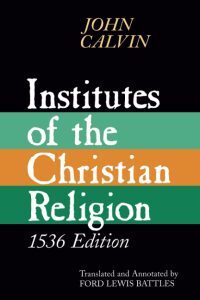
 Calvin’s 1536
Institutes
on Amazon
Calvin’s 1536
Institutes
on AmazonI’m so jazzed to tell you my book group is planning to read Calvin’s 1536 Institutes!
If you have been a regular here on my site you probably know that I have a theological book group through my Patreon page that’s been meeting each week via Zoom throughout the pandemic.
Every time we start a new book we open it up for new members. We’re just wrapping up an extraordinary journey through Julian of Norwich’s 14th century Revelations of Divine Love. In a couple weeks we start our new book. We’d love to have you along.
The upcoming book is dear to my heart. It is John Calvin’s 1536 Institutes of the Christian Religion.
Calvin’s 1536 InstitutesThe Institutes is the most famous systematization of Reformation theology. Earlier in the Reformation, most theological writing was focused on particular controversial topics or in the form of biblical commentaries. Calvin took all that and organized it for us.
When he first brought it out in 1536 he could accurately refer to it as a “little handbook.” In English translation it is only about 200 pages of fairly large print.
We’re not (currently!) taking on the 1559 final version of the Institutes. That is a much steeper climb — two hefty volumes of smaller print in English translation, filled with arguments more clear to 16th century theologians than today’s readers.
No, this is the early version, which presents Calvin’s summary of basic Christian teaching to the interested Christian reader. He dives into the core summaries Christians were expected to know, and explains them biblically and carefully.
What the Book is AboutIn my own words, that is
What Christians believe (aka the “Apostles’ Creed” as the essence of Biblical theology).How Christians connect to God (aka the “Lord’s Prayer” as guide to our own praying).How Christians can live a God-pleasing life (aka the “Ten Commandments” as guide to our ethical behavior).How God communicates his grace to us in worship (aka “The Sacraments” as powerful vehicles for the gospel of Christ).How Christians can organize themselves for a good and just society (aka “Government”).500 years later it is still a excellent tool to help Christians understand their faith and live lives of competent discipleship.
How the Reading Group WorksHere’s how it works. The Zoom link goes out through my Patreon page, to everyone who supports my work at the level called “The Education” or higher. (That’s $8.33 per month, which is $100 per year. That’s intended to be a handy round number for those joining via their continuing education budget.)
You can pick the book up on Amazon through this affiliate link. Look carefully on the page, because you’ll also find links to used copies that are much cheaper copies. (You might also look on Ebay, Alibris, AbeBooks, etc.)
Here’s the link to my Patreon page if you want to join us!
++++++++++++This page contains affiliate links. If you make a purchase on Amazon after clicking through, I get a little commission — though the price to you is exactly the same. Thanks!
The post Zoom Book Group — Calvin’s 1536 Institutes! appeared first on Gary Neal Hansen.
November 3, 2021
A Children’s Sermon on Mark 12:38-44 — Who’s Watching?
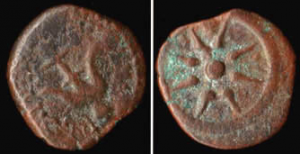
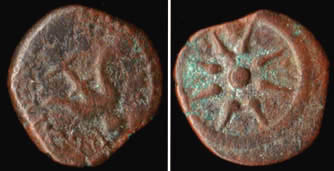 Widow’s Mite
Widow’s MiteAs I sit down to write my children’s sermon on Mark 12:38-44, life is a bit of a scramble. So, I’m not wading in with my usual comments on the process or on issues in the text.
Maybe you find that a relief. Maybe you’ll miss that stuff.Either way, here we go with a children’s sermon on Mark 12:38-44.
Let me know of you think it’s okay that I turned Jesus’ comments about the scribes into a dialogue with Peter.
Oh yeah: You can find my regular Monday Meditation on this text from a while back through this link.
A Children’s Sermon on Mark 12:38-44Good morning kids! I’m so glad to see you here in worship today. Thanks for coming up to hear the children’s sermon.
A Fancy RobeOne day, Peter had been praying in the Temple. He came out just as Jesus was passing by.
“Hey Jesus!” called Peter.
“Oh, hi Peter,” Jesus said. “Been to the Temple I see.”
“Yes!” Peter said, “And boy did everybody like my fancy new robe. Check it out!”
And Peter did a little twirl to show off his outfit.
“Nice,” said Jesus. And he meant it. But then he asked, “So, I’m curious: How come you bought a new robe just now? Your old one seemed pretty nice too.”
“Well Jesus, it’s like this,” said Peter. “I find that if I wear a bit fancier clothing people just seem to treat me better. I call it ‘dress to impress.’”
“I see,” said Jesus. “How did they treat you in the temple today?”
“I’m glad you asked,” said Peter. “When I swooped in with my long flowing robe people really took notice. They stood up out of respect when I passed by. The ushers led me to the best seat—front row! They even asked me to pray.”
“And did you?” asked Jesus.
“Oh yeah,” Peter said. “I gave them a really long prayer. One with a lot of big words in it. Again, I’d say they were very impressed.”
“I see,” said Jesus. “So that’s what’s really important to you? Impressing people with expensive clothes and fancy prayers?”
“Well, I guess. It felt pretty good,” he said.
Jesus looked at Peter for a second and said, “Remind me to tell you how you can be the greatest on the kingdom of God.”
“Oh you did,” said Peter. “Something about helping people, right?”
The Rich Man’s Offering“Ooh, check this out,” said Jesus. “People are bringing their offerings to the Temple.”
Peter tamed to see where Jesus was pointing. He saw a big wooden box, like a pirate’s treasure chest. There was a hole in the top for donations.
A rich man in nice clothes came up with a big bag of money. He shook it and the coins inside rattled and jingled.
Then he took out the big gold coins one by one, dropping each one down the hole with a “clink!” He did this for quite a while. There were a lot of “clinks”!
When the bag was half empty he shook it again. Then he turned it over and poured the coins down the hole—“Rumble, Jingle, Clink, Rumble, Jingle, Clink.”
His big coins made quite a lot of noise. A number of people looked at him with admiration. Others looked at him with envy. He didn’t seem to mind. He tucked his empty money bag back inside his robe, and walked off smiling.
“Wow!” said Peter. “That guy gave a lot of money. He’s really generous.”
The Widow’s Offering“Watch this,” said Jesus.
Just then a little old lady came quietly up to the big wooden offering chest. She was wearing the tattered black dress of a poor widow.
She had a bag too, but it looked like it was empty. She reached way down to the bottom of her bag. Then she brought her hand back out. She was holding two tiny copper coins.
She reached over the top of the chest and slipped her coins down the hole. They didn’t even make a sound. Then she walked quietly away.
“Well,” said Peter, “she didn’t give much.”
“Didn’t she?” asked Jesus. “I’d say she gave more than anybody.”
“No way,” said Peter. “She gave two tiny coins! That rich guy gave a whole bag of money.”
“That’s just it,” said Jesus. “He gave all that and he’s still a rich guy. He only gave a little bit of what he has. That poor widow gave all she had. That’s way more. At least in God’s eyes.”
Peter wasn’t sure what to say.
Wondering.I wonder if the rich man was hoping someone would see what he was giving to the Temple?I wonder how somebody begins to want to please God with what they do?I wonder what you and I might give to please God and help people?++++++++++++You are, of course, free to use this children’s sermon, or adapt it as you find most useful. But, if you use it, please do one (or more!) of the following.
You can let me know that you are using it, either in the comments below, or using the contact form above. You can put a little notice in your church bulletin that your children’s sermon is adapted from one published on GaryNealHansen.com.You can support my work over on Patreon. (Just $1 per month brings my children’s sermons straight to your inbox about two minutes after they go live. And every little bit keeps me going…)The post A Children’s Sermon on Mark 12:38-44 — Who’s Watching? appeared first on Gary Neal Hansen.
October 27, 2021
A Children’s Sermon on Mark 12:28-34–Living God’s Way

 Photo of LOVE statue, NYC (Public Domain)
Photo of LOVE statue, NYC (Public Domain)My children’s sermon on Mark 12:28-34 brings us into some strange lectionary territory.
“Mark 12?” you ask. “Last week we were on Mark 10! What happened to Mark 11?”
That, gentle reader, is exactly my point. We spent four weeks cruising happily through Mark 10, skipping only four verses along the way. Now we’ve jumped straight over a whole chapter.
(You can read my regular Monday Meditation on this text here.)
Actually we’ve already had the only piece of Mark 11 that the lectionary will ever give us. Mark 11:1-11 is the story of Palm Sunday, and we had it back at the end of Lent.
Now we’re cruising toward the end of Year B, with its focus on Mark. Two weeks from now we’ll be as far as Mark 13: 1-8, then we’re on to Year C and Luke.
“Ah” you say, “but what about the rest of Mark 13—and 14, 15 and 16?”
Well, we already had that too. A bit was a year ago in Advent, and the rest was during Holy Week.
Why do I go on about this so? Because it makes it hard for the congregation to see Mark as a coherent story.
It also matters for the preaching of these next three weeks: We encounter them almost randomly, at the end of Ordinary Time. In fact these three texts take place during Holy Week, those intense days between the “Triumphal Entry” on Palm Sunday and the Cross on Good Friday. Their meaning is shaped by that context.
Actually, we’ll have to see whether or not that Holy Week context affects my children’s sermon on Mark 12:28-34, or the ones to come.
A Children’s Sermon on Mark 12:28-34Good morning kids! I’m so glad you are here. Thanks for coming up to hear the children’s sermon.
You may remember that, in several of our stories recently, Jesus told his friends that hard things were going to happen. He kept saying that when he went to Jerusalem he would be arrested, and accused of bad things. He said people were going to hurt him and even kill him in Jerusalem.
Well, this story tells about one of the things that happened after he got to Jerusalem, but before the bad things started to happen.
A Good QuestionAfter Jesus got to Jerusalem, he spent several days hanging out around the temple. People came up and asked Jesus a lot of questions.
Some of the people asking the questions were not very nice. They asked tricky questions, trying to get Jesus to say something that would get him in trouble.
But one man was just watching. He listened to how Jesus answered all those tricky questions. He was impressed.
This man was a scribe. The scribes were total experts about the Bible and God’s laws. When people wondered how to live by God’s laws, they would ask a scribe. A scribe would know.
When this scribe heard how well Jesus answered everybody’s tricky questions, he came and asked Jesus a question of his own.
“Jesus,” he said, “can I ask you a question too?”
“That depends,” said Jesus. “Is it another one of those tricky questions?”
“No,” said the scribe, “I heard how you answered all of those. I just want to know your opinion on something.”
“Okay,” Jesus said, “what’s your question?”
The scribe paused for just a second, looking at Jesus. Then he asked, “Which of God’s commandments do you think is the most important of all?”
A DebateNow, the disciples were right there, listening to Jesus and the scribe talking. And, of course, they had their own opinions about the scribe’s question. And of course they all wanted to look like they were really smart by getting the right answer first.
Peter raised his hand up high. He was sort of bouncing from foot to foot. “Jesus! I know! I know!”
“What do you know, Pete?” Jesus asked.
“The answer!” Peter said.
“I do too!” said John.
“Me too!” said James, “Call on me!”
“Okay, okay, okay,” laughed Jesus. “What do you think is the most important commandment, Peter?”
“‘Do not steal'” said Peter.
“No,” said James, “’Do not murder’ is way more important.
“Um, you guys?” said John, “Don’t you think Moses maybe put the most important one first on the list? How about ‘Do not have any other gods’?”
How God Wants Us to LiveJesus smiled and said, “Okay, those are all good guesses. And they really are important commandments. But did you notice they all have one thing in common?”
The disciples thought for a minute. Then John spoke up. “They all start with ‘do not’?”
“Right,” said Jesus. “What’s missing?”
They thought again. And again John spoke up. “What are we supposed to be doing while we’re not killing, and not stealing, and all the other stuff?”
“Exactly,” said Jesus. “The most important commandment tells you what to actually do. It shows you the life God wants you to live.”
“What is it?” asked Peter.
“It’s in the book of Deuteronomy,” said Jesus. “It goes like this: ‘Hear, O Israel, the Lord your God, the Lord is One—”
“Hey!” said Peter, “I know that verse. But that’s not even a commandment! That just tells you who God is.”
“You’re interrupting, Peter,” said Jesus. “You know that verse because we all say it every day on our prayers. But it goes on, right? The verse says ‘the Lord your God, the Lord is one; and you shall love the Lord your God with all your heart, and with all your soul , and with all your mind, and with all your strength.’ That’s how God wants us all to live.”
How God ALSO Wants Us to Live“Doesn’t seem like that leaves me much time to do stuff for myself,” grumbled Peter. “All your mind? You mean I can’t even think of anything but God? What about caring for people?”
“No, Peter,” said Jesus. “It’s about using your whole life to please God. And God gives you your own life to take good care of. God wants you to look at the whole world the way he does—with love. That’s why the second greatest commandment is ‘You shall love your neighbor as yourself.’ That’s how God wants all our lives to work.”
“Oh,” said Peter. “Okay then.”
A New FriendThen the Scribe spoke up. “That was a great answer, Jesus. Loving God with everything, and loving other people as yourself really is what the whole Bible is about.”
“Thanks,” said Jesus, “You know, you are really pretty close to the Kingdom of God.”
“Thanks,” said the scribe.
And from that moment they became friends.
WonderingI wonder how life might be different if we always start by loving God?I wonder what makes it hard to love God with everything?I wonder if you’ve ever felt really and truly loved?I wonder if there are people that you love as yourself?++++++++++++You are, of course, free to use this children’s sermon, or adapt it as you find most useful. But, if you use it, please do one (or more!) of the following.
You can let me know that you are using it, either in the comments below, or using the contact form above. You can put a little notice in your church bulletin that your children’s sermon is adapted from one published on GaryNealHansen.com.You can support my work over on Patreon. (Just $1 per month brings my children’s sermons straight to your inbox about two minutes after they go live. And every little bit keeps me going…)The post A Children’s Sermon on Mark 12:28-34–Living God’s Way appeared first on Gary Neal Hansen.
October 21, 2021
Mercy — A Children’s Sermon on Mark 10:46-52

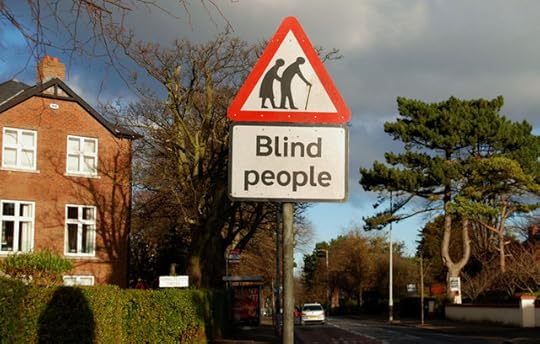 Blind People Sign, Belfast (CC by Albert Bridge-SA 2.0)
Blind People Sign, Belfast (CC by Albert Bridge-SA 2.0)
Sitting down to write a children’s sermon on Mark 10:46-52, I have to say it’s just the kind of text I find easiest to work with: a single story that makes a solid central point. It’s kind of a relief after so many twisty-turny texts patched together from disconnected parts.
(You can find my regular Monday Meditation on this text here.)
It’s also conveniently timed: these weeks have been full and complicated for me, and if the Sunday Gospel texts were hard I might have been in trouble. Even with an easy text, it’s taking me till Thursday to hit “publish” on this children’s sermon on Mark 10:46-52.
It’s the story hangs of a blind man who wants Jesus to heal him. (A typo in my draft had him as “Blond Bartimaeus.” I don’t know his hair color. The issue was his visual impairment.)
There are a number of odd and interesting details, however. That’s always what is most interesting to focus on.
I may won’t be able to highlight all the interesting bits. That’s okay: ideally a children’s sermon on Mark 10:46-52 (or any passage) should try to focus attention on just one point.
I think I’ve avoided last week’s pitfall. Last week I ended up building a long narrative context that would, eventually, make some sense of the text’s point. It was not a home run children’s sermon.
But then, many a ball game is won by bunts and base hits. Even simple walks move the players around the bases. Same goes for preaching.
A Children’s Sermon on Mark 10:46-52Good morning, kids! I’m so glad you’re here today. Thanks for coming up to hear the children’s sermon.
Asking for MercyOne day Jesus and his friends were traveling. They were just leaving the city of Jericho. (Maybe you remember the song about how Joshua fought a battle in Jericho, and the walls came tumbling down. Well that was a long, long, long time before Jesus and his friends came by.)
When they were heading down the road out of the city they heard a voice calling out.
“Jesus! Have mercy! Jesus! Have mercy!”
Let’s all pretend we are that person from Jericho who was calling out for help, okay? Lets’ say it together. One, two, three:
“Jesus! Have mercy! Jesus! Have mercy!”
Okay, pretty good, but you’re inside the city and Jesus is walking away, leaving town. Let’s make sure he hears us. One, two, three:
“Jesus! Have mercy! Jesus! Have mercy!”
Oh no! He’s walking farther away! We better try even louder. One, two, three:
“Jesus! Have Mercy! Jesus! Have Mercy!”
Grumpy NeighborsWell, I’m not sure if Jesus heard the voice yet but the people around the man who was calling out were getting really annoyed.
“Hey Bart!” somebody said. (The man’s name was Bartimaeus. Most people called him “Blind Bartimaeus,” but some called him Bart for short.) “Why don’t you stop shouting and do something useful for a change? All you ever do is sit here and beg.”
“Oh come on!” said Bart. “I’m blind. Nobody will give me a job, so I have to beg for food. I heard Jesus was in town and I think maybe he can help me.”
“But you’re bothering us with all your shouting!” someone else said. Bart didn’t know who it was because, of course, he couldn’t see.
“I don’t care,” Bart said. “I’m asking Jesus to help me.”
So he yelled even louder. Ready? One, two, three:
“Jesus! Have mercy! Jesus! Have mercy!”
A Conversation with JesusWell, at that point Jesus definitely heard Bart calling.
“Someone’s calling for help,” said Jesus.
“Oh, it’s just some beggar,” said Peter. “Let’s keep going.”
“Everybody needs help sometimes,” said Jesus. “And when you need help, the best thing to do is to ask someone. Go get him please.”
So, they went and found Bart, and they brought him to Jesus.
“Hello!” said Jesus. “I heard you calling. How can I be of help?”
“Oh Jesus!” said Bart, “Won’t you please have mercy on me!”
Different Kinds of Mercy“I’m happy to,” said Jesus, smiling. (Jesus knew Bart couldn’t see, so he put his smile into his voice.) “But what kind of mercy do you need?”
“What do you mean?” asked Bart.
“Well,” said Jesus, “every time someone helps someone else, that’s mercy.
Some people are hungry. They need someone to have mercy and feed them. Some people are lonely. They need someone to have mercy and love them. Some people have done bad things. They need someone to have mercy and forgive them.It’s all mercy. What kind of mercy do you need?”
A Healing“I’m blind,” said Bart. “I want to be able to see!”
Then Jesus gave him exactly that. Suddenly “Blind Bartimaeus” could see!
“Wow!” said Bart. “How did that happen?”
“It was your faith, actually,” said Jesus. And this time, Bart could see Jesus smiling.
“Faith?” said Bart. “How do you know I had faith?”
“Easy,” said Jesus. “Because you asked for mercy. You wouldn’t have asked if you didn’t believe I would help.”
Wondering I wonder what it felt like to be blind and have to beg for food? I wonder what kept Bartimaeus calling out for mercy when people told him to be quiet? I wonder what it felt like when Jesus asked Bartimaeus exactly what he wanted? I wonder what kinds of mercy you would like to ask Jesus for? ++++++++++++You are, of course, free to use this children’s sermon, or adapt it as you find most useful. But, if you use it, please do one (or more!) of the following.
You can let me know that you are using it, either in the comments below, or using the contact form above. You can put a little notice in your church bulletin that your children’s sermon is adapted from one published on GaryNealHansen.com. You can support my work over on Patreon. (Just $1 per month brings my children’s sermons straight to your inbox about two minutes after they go live. And every little bit keeps me going…)The post Mercy — A Children’s Sermon on Mark 10:46-52 appeared first on Gary Neal Hansen.



